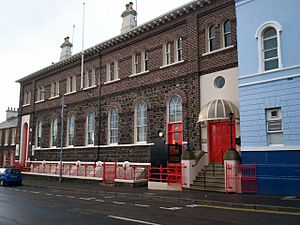Lurgan Town Hall facts for kids
Quick facts for kids Lurgan Town Hall |
|
|---|---|

Lurgan Town Hall
|
|
| Location | Union Street, Lurgan |
| Built | 1868 |
| Architect | William Raffles Brown |
| Architectural style(s) | Italianate style |
|
Listed Building – Grade B1
|
|
| Official name: Town Hall, Union Street, Lurgan, County Armagh | |
| Designated | 14 August 1981 |
| Reference no. | HB 14/23/030 |
| Lua error in Module:Location_map at line 420: attempt to index field 'wikibase' (a nil value). | |
Lurgan Town Hall is an important building in Union Street, Lurgan, County Armagh, Northern Ireland. It's mainly used today as a place for community events, arts, and learning. This historic building is officially recognized as a Grade B1 listed building, which means it's protected because of its special history and architecture.
Contents
The Story of Lurgan Town Hall
Building a New Town Hall
In 1855, new leaders called town commissioners were chosen in Lurgan. They wanted to make the town better by building new places. These included a police station, a workhouse (a place where poor people could live and work), and a new courthouse. They also planned a new town hall. This was a big step forward for the town.
The design for the new town hall was created by an architect named William Raffles Brown. He used a style called Italianate architecture, which was popular at the time. The building was made from rubble masonry (rough stones) and red brick. It cost about £2,300 to build, which was a lot of money back then! The town hall was finished in 1868.
Design and Features
The town hall has a balanced look with nine sections facing Union Street. The parts at each end have round doorways that you reach by climbing steps. The other sections on the ground floor have round-shaped windows. Upstairs, there are pairs of smaller round windows. The roof has a decorative edge that sticks out a little. Inside, the main hall was the biggest room. It could hold about 250 people for meetings or events.
Changes Over Time
Over the years, the town hall was updated. In 1895, a local builder named W. J. Martin added a library inside the building. A few years later, in 1899, Lurgan became an urban district, and the town hall became its main office.
In 1906, the library moved to a new building on Carnegie Street. This new library was built with a lot of help from a rich Scottish-American businessman named Andrew Carnegie. He helped build many libraries around the world.
In 1962, a large crowd of 1,200 people gathered in the main hall. They came to hear a speech by Ian Paisley, who later became an important political leader in Northern Ireland.
Modern Use of the Town Hall
The town hall was the meeting place for the local council for most of the 20th century. However, in 1973, a larger council called Craigavon Borough Council was formed, and the town hall was no longer the main government building.
After a nearby police station was damaged in 1973, parts of the town hall were used temporarily by the police. In 1985, the building became a community, arts, and resource centre. This means it's now a place where people can gather, enjoy art, and find helpful information.
In July 1997, a special plaque was placed outside the town hall. It honors Rifleman William McFadzean, a brave soldier from the Royal Irish Rifles. He was given the Victoria Cross, which is a very high award for bravery, for his actions during the First World War in 1916.
Inside the town hall, you can also see some interesting art. There's a painting of the 3rd Lord Lurgan and a bronze statue of the Irish writer, George William Russell, made by Jerome Connor.

